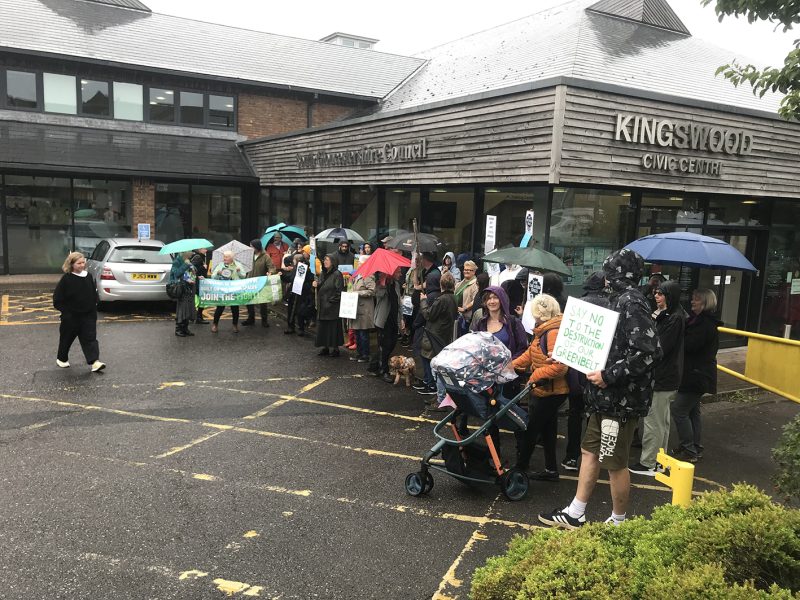PROTESTERS staged a demonstration at Kingswood Civic Centre against proposals for thousands of homes on the green belt.
The demo, organised by South Our Green Spaces (SOGS) South Gloucestershire, was held before council leaders approved the next stage of a blueprint for the future of the district, including where more than 22,000 homes could be built.
The group of about 50 people, bearing placards, marched in the rain from Kings Chase shopping centre for the South Gloucestershire Council cabinet meeting. Residents urged councillors to think again over the strategy, which includes thousands of homes on green fields in Hanham, Warmley, Shortwood and Siston.
The proposals for 22,241 homes to be built from 2025 to 2040 are contained in the latest version of South Gloucestershire’s Local Plan, which is going out to consultation, after which the document will be finalised, consulted on again and then sent to government planning inspectors for examination.
Seventeen new sites, with a total of 1,751 homes, are identified in the new version. These include 225 homes in the green belt at Jarrett’s Yard, Oldland Common, 40 on a site next to Bitton Sports and Social Club and 45 at Cemex Floors in Wick.
A report to the meeting on July 15 said the additional sites had been added to give the council a “buffer” in case some of the proposed developments did not go ahead. It insisted that these still were not enough to meet any of Bristol’s unmet housing needs and that South Gloucestershire could not do anything to help its city council neighbour. Despite this, South Glos had fulfilled its legal “duty to cooperate” with Bristol when preparing the Local Plan, the report said.
(SOGS) South Gloucestershire member Martin Thomas told the cabinet: “Bristol’s housing need should be kept inside Bristol and it should be building up, not out into the countryside.
The proposals for large-scale development in on the eastern fringe of the city lacked imagination and were “the lazy way to provide new homes”, he said.
John Sibley, who said he had lived in Warmley all his life, pleaded with councillors not to destroy his village by turning it into a suburb, while Thomas Garland said the plans risked causing huge environmental damage.
Darren Lawrence told the meeting: “I will create an army of people to push back against this madness.”
Opposition leader Councillor Sam Bromiley (Conservative, Parkwall and Warmley), said the SOGS campaigners were standing up for their community and should be shown respect.
Cabinet member for planning, regeneration and infrastructure Cllr Chris Willmore (Lib Dem, Yate North) said: “In a worst possible case, if all the sites the council was looking at were to be released, it would be a two per cent loss to the current green belt, but we’re working to get it down as low as we possibly can.”
She said 20 per cent of South Gloucestershire residents lived in insecure, unaffordable housing with no chance of getting on the property ladder and that renting often required 70 per cent of their monthly income, with a one-bedroomed flat in Kingswood costing £1,000 and month and a room in a shared house £750.
Cllr Willmore said: “We’ve got to do something about that, and the only way we can do that is by producing higher numbers of social rent and affordable housing for local people.
“What we have to do as responsible leaders in our communities is find spaces where we think the least worst harm is done and find ways to mitigate the harm that is inevitable with new development.”
She said she was willing to meet any group for positive discussions about how the housing need can be met with the lowest impact on the green belt.
Council co-leader Cllr Ian Boulton (Labour, Staple Hill & Mangotsfield) said that while South Gloucestershire did not have a Local Plan, all green spaces in the district could be targeted by developers.
“By having a Local Plan it protects the green spaces because we’re not having to fight off those speculative developments,” he said.
Public consultation began in late July and will close the week ending September 13.
Following feedback, the final version will be prepared and consulted on again next January before being submitted in June 2025 for examination, which is expected in October next year, ahead of adoption by April 2026.
By Adam Postans, Local Democracy Reporting Service


